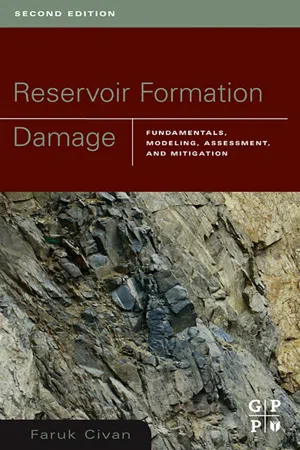1.1 INTRODUCTION
Formation damage is a generic terminology referring to the impairment of the permeability of petroleum–bearing formations by various adverse processes. Formation damage is an undesirable operational and economic problem that can occur during the various phases of oil and gas recovery from subsurface reservoirs including drilling, production, hydraulic fracturing, and workover operations (Civan, 2005). As expressed by Amaefule et al. (1988), “Formation damage is an expensive headache to the oil and gas industry.” Bennion (1999) described formation damage as, “The impairment of the invisible, by the inevitable and uncontrollable, resulting in an indeterminate reduction of the unquantifiable!” Formation damage assessment, control, and remediation are among the most importantissues to be resolved for efficient exploitation of hydrocarbon reservoirs (Energy Highlights, 1990). Formation damage may be caused by many factors, including physico-chemical, chemical, biological, hydrodynamic, and thermal interactions of porous formation, particles, and fluids, and the mechanical deformation of formation under stress and fluid shear. These processes are triggered during the drilling, production, workover, and hydraulic fracturing operations. Ordinarily, the mineral matter and fine particles loosely attached to the pore surface are at equilibrium with the pore fluids. However, variations in chemical, thermodynamic, and stress states may create nonequilibrium conditions and induce the salinity, velocity, and thermal shock phenomena and particle detachment and precipitate formation. When the equilibrium condition existing between the pore surface and the fluids is disturbed during reservoir production by primary and enhanced recovery processes, the mineral matter may dissolve and generate many different ions in the aqueous phase and the fine particles are unleashed from the pore surface into the fluid phases. Once these ions and particles are introduced into the fluid phases, they become mobile. Thus, a condition is created, like a bowl of soup of the mobile ions and fine particles in the pore space, which may interact freely with each other in many intricate ways to create severe reservoir formation damage problems.
Formation damage indicators include permeability impairment, skin damage, and decrease of well performance. As stated by Porter (1989), “Formation damage is not necessarily reversible” and “What gets into porous media does not necessarily come out.” Porter (1989) called this phenomenon “the reverse funnel effect.” Therefore, it is better to avoid formation damage than to try to restore it. A verified formation damage model and carefully planned laboratory and field tests can provide scientific guidance and help develop strategies to avoid or minimize formation damage. Properly designed experimental and analytical techniques, and the modeling and simulation approaches can help understanding diagnosis, evaluation, prevention, remediation, and controlling of formation damage in oil and gas reservoirs.
The consequences of formation damage are the reduction of the oil and gas productivity of reservoirs and noneconomic operation. Therefore, it is essential to develop experimental and analytical methods for understanding and preventing and/or controlling formation damage in oil- and gas-bearing formations (Energy Highlights, 1990). The laboratory experiments are important steps in reaching an understanding of the physical mechanisms of formation damage phenomena. “From this experimental basis, realistic models which allow extrapolation outside the scaleable range may be constructed” (Energy Highlights, 1990). These efforts are necessary to develop and verify accurate mathematical models and computer simulators that can be used for predicting and determining strategies to avoid and/or mitigate formation damage in petroleum reservoirs (Civan, 1994).
Confidence in formation damage prediction using phenomenological models cannot be gained without field testing. Planning and designing field test procedures for verification of the mathematical models are important. Once a model has been validated, it can be used for accurate simulation of the reservoir formation damage and designing effective measures for formation damage mitigation. Current techniques for reservoir characterization by history matching do not consider the alteration of the characteristics of reservoir formation during petroleum production. In reality, formation characteristics vary (Civan, 2001, 2002a, b, e) and a formation damage model can help to incorporate this variation into the history matching process for accurate characterization of reservoir systems and, hence, an accurate prediction of future performance.
Formation damage is an exciting, challenging, and evolving field of research. Eventually, the research efforts will lead to a better understanding and simulation tools that can be used for model-assisted analysis of rock, fluid, and particle interactions and the processes caused by rock deformation and scientific guidance for development of production strategies for formation damage control in petroleum reservoirs. In the past, numerous experimental and theoretical studies have been carried out for the purpose of understanding the factors and mechanisms that govern the phenomena involving formation damage. Although various results were obtained from these studies, a unified theory and approach still does not exist. In spite of extensive research efforts, development of technologies and optimal strategies for cost-effective mitigation of formation damage is still as much art as science. Civan (1996) explains
A formation damage model is a dynamic relationship expressing the fluid transport capability of porous medium undergoing various alteration processes. Modeling formation damage in petroleum reservoirs has been of continuing interest. Although many models have been proposed, these models do not have the general applicability. However, an examination of the various modeling approaches reveals that these models share a common ground and, therefore, a general model can be developed, from which these models can be derived. Although modeling based on well accepted theoretical analyses is desirable and accurate, macroscopic formation damage modeling often relies on some intuition and empiricism inferred by the insight gained from experimental studies.
As J. Willard Gibbs stated in a practical manner, “The purpose of a theory is to find that viewpoint from which experimental observations appear to fit the pattern” (Duda, 1990). Civan (1996) states
